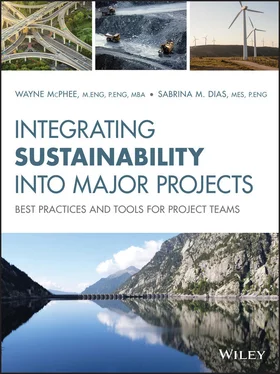For an EPCM project to successfully integrate sustainability it is important to clearly identify how both organizations are responsible for meeting project commitments and how sustainability will be incorporated into all project activities. Involvement of the EPCM firm typically ends when commissioning is finished. Project contracts should build incentives into project delivery that optimize long-term performance, secure community support, and help to build local capacity in order to maximize local employment and procurement. In other words, identify and utilize innovative solutions that are not part of the EPCM firm's typical, off-the-shelf design solutions.
Engineering, Procurement, and Construction (EPC)
The engineer, procurement, and construct (EPC) project structure, also known as design-build, is a variation on EPCM where the owner hires a consulting firm to complete the full project delivery of the project, including full control over the project construction, and then hands the project over to the owner for operations during commissioning. In the traditional EPC contract, the owner is still responsible for financing and sustainability activities but has less control over procurement and selection of contractors. This is especially true when the EPC contract is structured as a fixed-price contract that provides a strong incentive for the EPC firm to minimize overall costs with no incentive to build or maintain community support.
From a sustainability perspective the EPC project structure can be difficult to integrate environmental and social goals into project delivery. For example, renewable power systems that have a large capital cost but low operating costs may be rejected in favor of traditional hydrocarbon power plants that come with lower capital costs and lower short-term risks. As with EPCM contracts, it is important to clearly identify who is responsible for meeting project commitments, how sustainability will be incorporated into all project activities, and how incentives will be used to optimize long-term performance, maintain community support, build a strong local workforce, and utilize innovative solutions.
Design-Build-Finance-Own-Operate (DBFOO)
There are a number of different project types that use variations on the concept of design-build-finance-own-operate (DBFOO) contracts depending on who provides financing and how the operations and maintenance contract is structured. DBFOO is often used for infrastructure projects where the owner can hand over all activities to the DBFOO firm to both deliver the project and operate the project over a specified period of time. In a DBFOO contract the owner is still responsible for financing the project and pays the firm in specified installments over the life of the project. The DBFOO firm provides initial project financing and the owner provides a set annual operations payment throughout the operations. The DBFOO firm recovers its investment from these operations payments.
In these contracts, the owner also hands over significant control of project delivery to the DBFOO firm. Therefore, a clear understanding of who will be responsible for sustainability and community engagement is important. The owner and the DBFOO firm need to have a common understanding of the sustainability requirements and expectations so that project success can be realized for both parties. The DBFOO firm may need only a bare minimum of community support to build and operate the project to recover their investment, but the owner may be looking for a higher level of community engagement and acceptance.
One of the key advantageous of a DBFOO contract is that it shifts the time horizon of the typical EPC structure. Now the project development firm has a strong incentive to manage long-term operating costs and community support since they will also be operating the project for a set period of time. The time horizon for DBFOO contracts is longer than EPC contracts but it is still important for the owner to specify project conditions at exit of the contract. This is to prevent the risk that the DBFOO firm will reduce their attention to key environmental and social aspects toward the end of the contract, lose community support, and leave the owner with an asset that requires significant investment to repair and maintain.
Public-Private Partnership (P3)
The use of public-private partnerships (P3s) gained popularity in the 1990s as a way for governments to reduce the tax investment required for infrastructure projects. Similar structures have also been used in resource projects where governments share in the investment in access roads or ports for resource areas and then recover the investment from user fees or tolls on the roads.
Although in theory creating a partnership between the private and public sectors should create the best potential for a well-integrated sustainability program, the public piece of the partnership was typically the government rather than the local community or the general public. As we will discuss later in this chapter, the government and the local community are often two distinct players with diverging interests in the project. In some cases, P3 projects have led to poor sustainability outcomes and in extreme cases a loss of community support, lawsuits, and protests. P3 project teams need to integrate sustainability into project delivery to ensure that they have local community support, ensure that positive opportunities are achieved, and create better projects.
P3 contracts should clearly identify who is responsible for meeting project commitments, how sustainability will be incorporated into all project activities, and how incentives will be used to optimize long-term performance, maintain community support, build a strong local workforce, and utilize innovative solutions.
People-Public-Private Partnership (P4)
As discussed above, the ‘“public” in a P3 agreement is not typically the general public or local community, but the government. As projects continue to evolve and incorporate social responsibility, some projects are adding a fourth “p” representing the local people and creating P4: a people-public-private partnership structure. This type of project structure would help ensure participation and support from the local communities. P4 structures provide an approach that improves attention to and discussion regarding community concerns and potential benefits (i.e. steady revenue from infrastructure, long-term employment for local communities), and provides good risk management for the government, operators, and financial organizations by ensuring that the local community has a seat at the table.
P4 strategies are not well developed yet but they represent a possible solution for economic development infrastructure projects and for portions of resource projects, especially infrastructure (roads, water treatment, and power). P4 structure could provide benefits for the project owner, the government, and the local community.
Summary of Project Structures
There is no project structure that works specifically to ensure sustainability is effectively integrated into project delivery. Each structure has advantageous and disadvantageous that can make integration easier or harder, but each system still requires a well-organized program to integrate sustainability into project management and delivery.
Figure 2.1summarizes some of the sustainability strategies that can be implemented to counterbalance the difficulties with each of the main project structures discussed above. The table is arranged with the project structures that provide the owner with the highest level of control over the sustainability program at the top and the least control at the bottom. The types of challenges to managing sustainability in each structure are provided, as well as some high-level strategies to help integrate sustainability into the project.
Читать дальше












